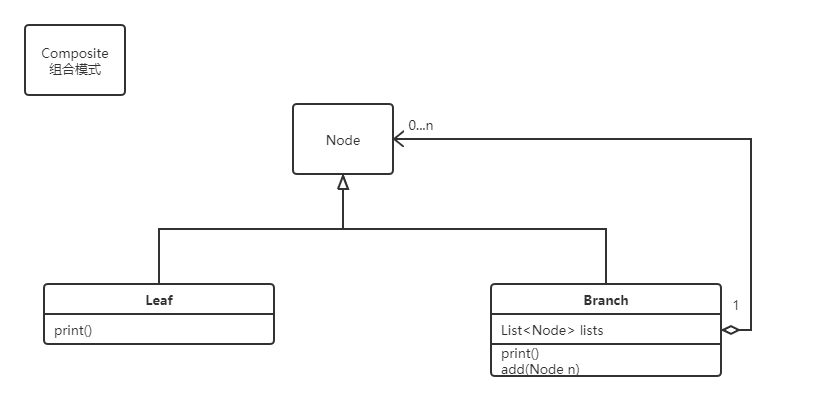本文最后更新于:3 years ago
组合模式(Composite Pattern),又叫 部分整体模式 ,是用于把一组相似的对象当作一个单一的对象。组合模式依据树形结构来组合对象,用来表示部分以及整体层次。这种类型的设计模式属于结构型模式,它创建了对象组的树形结构。
这种模式创建了一个包含自己对象组的类。该类提供了修改相同对象组的方式。
如果想了解组合模式的具体的介绍,菜鸟教程介绍得比较详细↓
菜鸟教程-组合模式
结构图

优缺点
优点:
1、高层模块调用简单。
2、节点自由增加。
缺点: 在使用组合模式时,其叶子和树枝的声明都是实现类,而不是接口,违反了依赖倒置原则。
使用场景
部分、整体场景,如树形菜单,文件、文件夹的管理。
实现代码
组合模式是很简单的模式,这里就模拟一下树的结构
先创建一个 Node 抽象类,里面有一个抽象的打印方法。
| abstract class Node {
abstract public void p();
}
|
接着创建 LeafNode 类和 BranchNode 类来继承 Node 抽象类。
LeafNode 表示叶子节点,BranchNode 表示存在子节点的节点。
LeafNode 和 BranchNode 中都定义一个content,用来输出时表示这个节点是什么,
其中 BranchNode 中还定义了一个 List 类型的 nodes 用来存储 BranchNode 下面的节点。
1
2
3
4
5
6
7
8
9
10
11
12
13
14
15
16
17
18
19
20
21
22
23
24
25
26
27
28
29
30
31
| class LeafNode extends Node {
String content;
public LeafNode(String content) {
this.content = content;
}
@Override
public void p() {
System.out.println(content);
}
}
class BranchNode extends Node {
List<Node> nodes = new ArrayList<>();
String content;
public BranchNode(String content) {
this.content = content;
}
@Override
public void p() {
System.out.println(content);
}
public void add(Node node) {
nodes.add(node);
}
}
|
最后就是写出主函数,我们创建一个根结点,然后根节点下面存在很多其他的子节点和叶子节点,
最后,用递归的方式完成输出:
1
2
3
4
5
6
7
8
9
10
11
12
13
14
15
16
17
18
19
20
21
22
23
24
25
26
27
28
29
30
31
32
33
34
35
| public class Main {
public static void main(String[] args) {
BranchNode root = new BranchNode("root");
BranchNode chapter1 = new BranchNode("chapter1");
BranchNode chapter2 = new BranchNode("chapter2");
Node c11 = new LeafNode("c11");
Node c12 = new LeafNode("c12");
BranchNode b21 = new BranchNode("section21");
Node c211 = new LeafNode("c211");
Node c212 = new LeafNode("c212");
root.add(chapter1);
root.add(chapter2);
chapter1.add(c11);
chapter1.add(c12);
chapter2.add(b21);
b21.add(c211);
b21.add(c212);
tree(root, 0);
}
static void tree(Node b, int depth) {
for (int i = 0; i < depth; i++)
System.out.print("--");
b.p();
if (b instanceof BranchNode) {
for (Node n :
((BranchNode) b).nodes) {
tree(n, depth + 1);
}
}
}
}
|
输出结果:
| root
--chapter1
----c11
----c12
--chapter2
----section21
------c211
------c212
|
